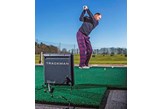How a launch monitor can help you
Published:
Until the 1960s almost all golf coaching was via the spoken and written word. Good golf teachers would turn their spoken words into pictures by demonstrating the golf swing and various shots.
Early photography, with limited shutter speeds, would often distort the shaft’s movement. The great Ben Hogan dabbled with early home cinema cameras and recorded his swing for posterity; his great friend Claude Harmon, was also a pioneer in the use of photos and video to teach golf. Today the modern camera captures the golf swing in every minute detail; the image can even be paused without any distortion at all.
Video: The electronic mirror
People often ask me what I think of video cameras; I reply (tongue in cheek) that I think they are wonderful for weddings and bar mitzvahs, but very limited for teaching golf. It reminds me of the man who went to the doctor in a state of great concern. “Doc – I woke up and looked in the shaving mirror; I had red eyes, pale complexion, shivering shoulders, a high temperature and, to top it off, I’m covered in red spots. I’ve got five things wrong with me!” “No” replied the Doctor, “you’ve got measles”.
While the mirror might record the symptoms, there is no cure in the mirror itself. If the Doctor had not correctly diagnosed the illness, the hapless patient would have merely dealt with the symptoms. Like a Doctor, the golf teacher has to spot the single fault that causes those symptoms and kill it!
Launch monitors: A 3D mirror
Readers will be familiar with the latest technology of launch monitors – effectively they provide a video of the ball’s flight and calculate the behaviour of the clubface at impact. Radar technology should really be called “shot monitors” as they track the ball’s flight and then calculate the clubface’s impact on the ball. I prefer the GC2 launch monitor (right) as it genuinely monitors “launch” by taking 23 images in the 10 inches immediately after impact. Launch monitors provide a huge amount of statistical information regarding the flight of the ball and behaviour of the club’s face. My question is this – does more information necessarily lead to more understanding?
Should you try a launch monitor?
Absolutely! But I say that on one condition – you must consult your local PGA professional. They will explain the statistics and prescribe a clear and simple course of action towards improvement. Whether a jigsaw puzzle is 10 pieces, 100 pieces or 1,000 pieces, on completion there should be one clear image. While a launch monitor provides the pieces of a very complex jigsaw puzzle, it is your pro’s job to give you the lid. While the pieces of themselves are merely fragments of information, it is the lid of the jigsaw puzzle that provides understanding.
What you can learn from a launch monitor
Let’s face it, among male golfers in particular, the one statistic that really matters is “how far have I hit it?” Yet there is a lot more to be gained from the figures than distance alone:
- Distance (carry): This is very helpful as you can easily identify the distance your irons fly through the air and you can “gap test” the lofts for consistency.
- Distance (overall): This stat is more helpful for testing your woods, particularly your driver. It allows you to test a driver against your current one and see if you really do need to invest in a new club.
- Clubhead speed: Your pro can assess your clubs and by testing various shafts and head weights, might be able to find you some extra yards.
- Launch angle: A pro can optimise your launch angle by testing various clubface lofts in conjunction with your ideal shaft. This may be news to you, but all experienced teachers know a lofted driver tends to encourage draw spin, leading to greater distance. It’s better to hit a draw with a 12-degree driver than a fade with a nine.
- Dispersion: Essentially your pro is measuring your accuracy. You will probably find that your swing technique is the most influential factor in dispersion – in short, it’s the Indian, not the arrow!
- Clubface at impact: It’s not rocket science to understand the effect of a closed or open blade – the art is teaching a golfer how to change without blinding them with too much science.

